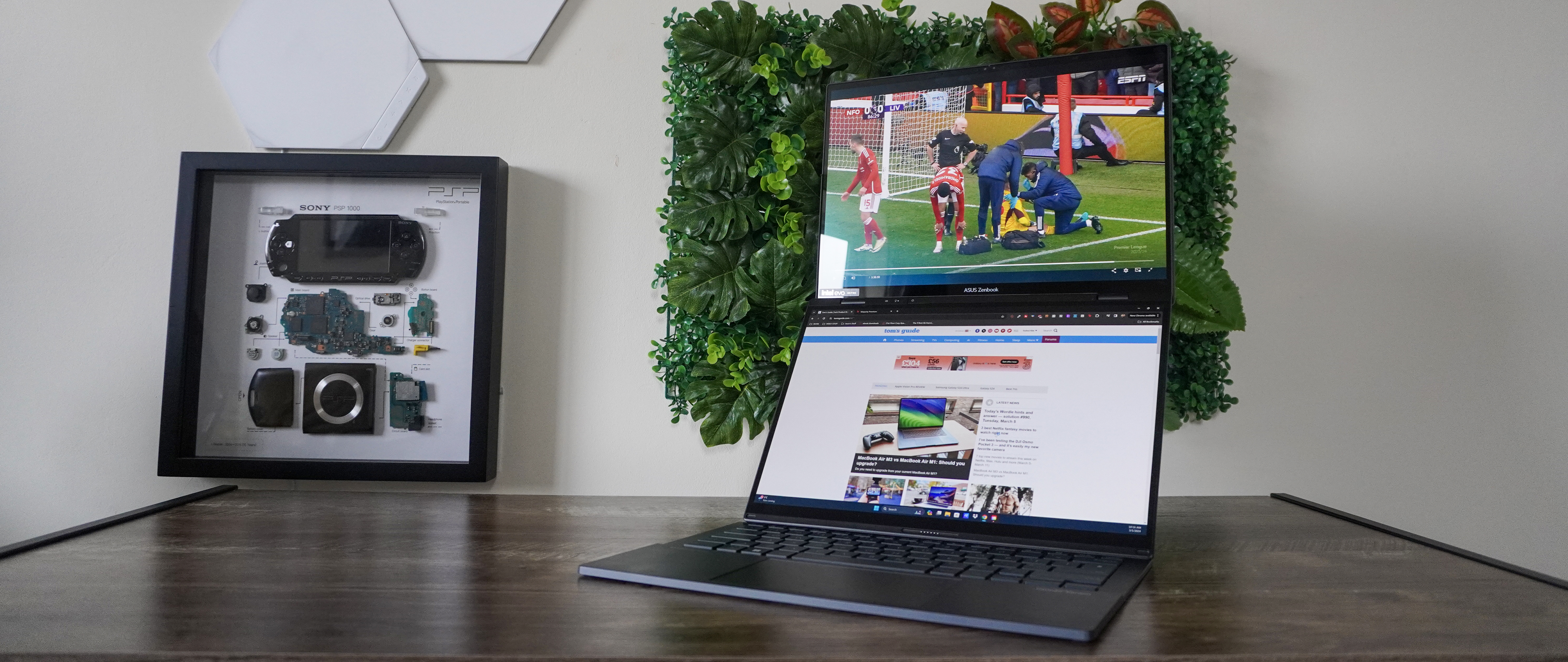Tom's Guide Verdict
The Asus Zenbook Duo perfects the dual-screen laptop formula with two gorgeous 14-inch OLED displays, and it has transformed this skeptic’s mind with its prime multitasking prowess and plenty of power. Now if only Microsoft could improve Windows 11 support for this burgeoning form factor.
Pros
- +
Two beautiful 14-inch OLED displays
- +
A powerful multitasking revolution
- +
Sleek, structurally sound build
- +
Best Keyboard and touchpad on a dual-screen laptop
- +
Value for money at $1,499
Cons
- -
Speakers are tinny
- -
Does heat up fast
- -
Webcam is more like a Game Boy camera
- -
Give me more ports, please!
Why you can trust Tom's Guide
Throughout the years, I’ve become a skeptical guy when it comes to gimmicks. 3DTVs? You bet. Foldable phones? Absolutely. And as I first looked at the Asus Zenbook Duo, I felt that same concern in my bones.
However, I’ll happily admit I’m wrong. Not only is it the complete opposite of a gimmick, you’re looking at one of the best laptops of 2024. And it comes down to learning what is truly possible by having two 14-inch 3K OLED displays at your disposal. The versatility of multitasking opportunities makes this a dream to use in all of my workflows, and it will for you too — even if that means distracting yourself with Netflix on the top screen while typing on the bottom!
Unlike other dual-screen laptops like the Lenovo Yoga Book 9i and HP Spectre Fold, no compromises are made where it matters. Namely, you’re getting the latest internals courtesy of Intel Core Ultra chips, the build quality feels a lot more solid, the keyboard and touchpad feel great to use, and at $1,499, the Duo doesn’t annihilate your bank balance.
That’s not to say there aren’t some compromises. The laptop's battery life takes a hit with those two screens, you’ll feel it get hot fast under strain, and the speakers are rather weak on the bass.
But make no mistake about it. This is the first dual-screen laptop we’d actually recommend to everyone. These gripes fade away in the face of what is a huge step forward for the Zenbook Duo lineage, so Microsoft needs to play catch up with updating Windows 11 to better support portables of this nature.
Asus Zenbook Duo (2024): Cheat sheet
- What is it? This is a dual-screen laptop — one in a new crop of systems that bring new multitasking capabilities.
- Who’s it for? If you prefer a multi-monitor setup for peak productivity, this is the laptop for you.
- What’s the price? The starting price for the Asus Zenbook Duo is $1,499.
- How does this compare to single-screen laptops? Looking beyond the obvious answer of saying it has a second screen, this has been a game-changer for productivity — being able to have multiple windows up across two displays rather than being crammed into one.
- What sacrifices are made in going dual-screen? There are two key drawbacks to using a dual-screen laptop. First, the increased amount of display hardware seems to have compromised the speaker quality. And second, the battery life has taken a hit.
Asus Zenbook Duo (2024): Specs
| Header Cell - Column 0 | Asus Zenbook Duo |
|---|---|
| Price | $1,499 (starting) |
| Display | Dual 14-inch 3K OLED displays, 16:10 aspect ratio, 120Hz refresh rate, 500 nits peak brightness |
| CPU | Intel Core Ultra 7 155H (upgradeable to Ultra 9 185H) |
| GPU | Integrated Intel Arc graphics |
| Memory | Up to 32GB LPDDR5x |
| Storage | Up to 1TB PCIe Gen 4 |
| Ports | 2x Thunderbolt 4, 1x USB 3.2 Gen 1 Type-A, 1x HDMI 2.1, 1x Audio jack |
| Connectivity | Wi-Fi 6e, Bluetooth 5.3 |
| Dimensions | 12.3 x 8.5 x 0.8 inches (with bluetooth keyboard) |
| Weight | 3.6 pounds (with bluetooth keyboard) |
Asus Zenbook Duo (2024): The ups
There’s a lot to love when it comes to the Asus Zenbook Duo — all combining to make for a peak productivity machine.
The displays are gorgeous
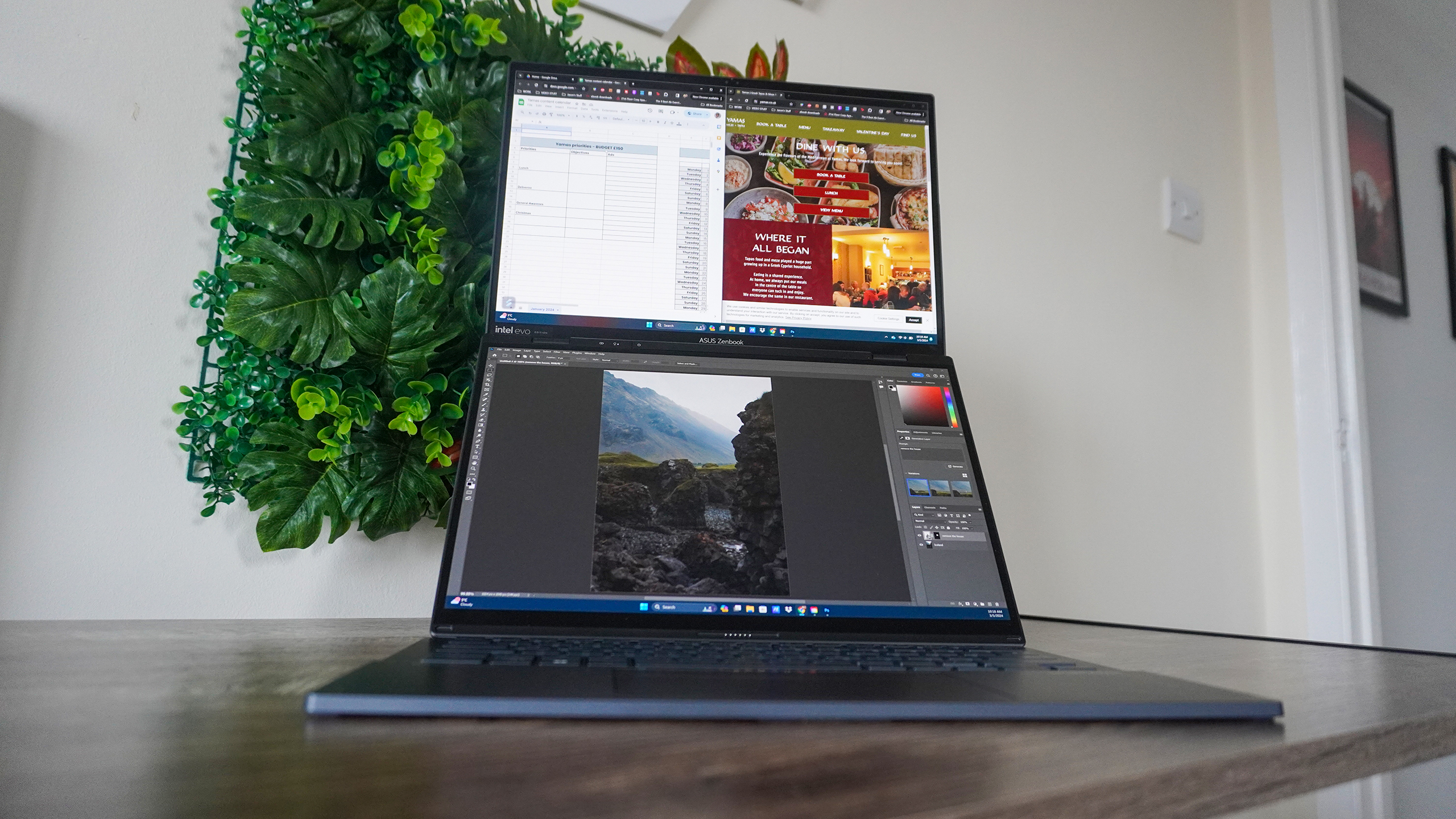
My oh my, the Zenbook Duo has come a long way since its initial awkward years. From the bizarre second touch display on the bottom deck that I reviewed for Laptop Mag, Asus has gone all in on the dual-screen deliciousness with a second 14-inch OLED panel.
OLED has become Asus’ bread and butter, and with a 120Hz refresh rate, everything feels full of vivid color and super smooth to interact with — especially to the touch. Firing up the GTA 6 trailer for the 150th time really highlights the HDR-esque breadth of contrast leveling, as the lights of this Miami-inspired region pop off the screen with impressive luminosity.
The numbers somewhat back this up to, because while you can find more vividity and brightness in its pricier competition, you can have confidence in this display's color accuracy.
| Laptop | DCI-P3 color gamut (%) | Average brightness (nits) |
|---|---|---|
| Asus Zenbook Duo (2024) | 80.5% | 350.8 |
| Lenovo Yoga Book 9i | 136.5% | 343.8 |
| HP Spectre Fold | 82.1% | 504.4 |
The magic doesn’t just lie in the dual OLEDs at play here, though. It’s all about what you can do with them. Split-screen multitasking is not a new concept — chances are you’re reading this on one half of your screen with another app open on the other.
But on a single laptop screen, that can feel a little cramped. Spreadsheets you’re looking at can be cut off, busy websites can quickly turn chaotic, and Photoshop is rendered unusable when sandwiched to the side of a display. Increase that to two landscape 16:10 panels and you’ve got so much more room that it transformed my way of working and drastically sped up my productivity. Plus, Asus’ use of multi-touch gestures and quick menus to snap windows to certain quadrants is easy,
Flip it into portrait, and you’ve got a typists dream with a full vertical view of your page as if you’re looking at an A4 sheet of paper (more on the keyboard experience later), while looking at whatever inspiration has fuelled your typing fingers on the other screen — for me, being a combination of looking at the Zenbook Duo’s test results and picking music on Spotify as I write this.
Put simply, I’ve tried several dual-screen laptops in the past. This is the most refined version of this form factor, and one I would heartily recommend to anyone.
Structurally sound and sleek
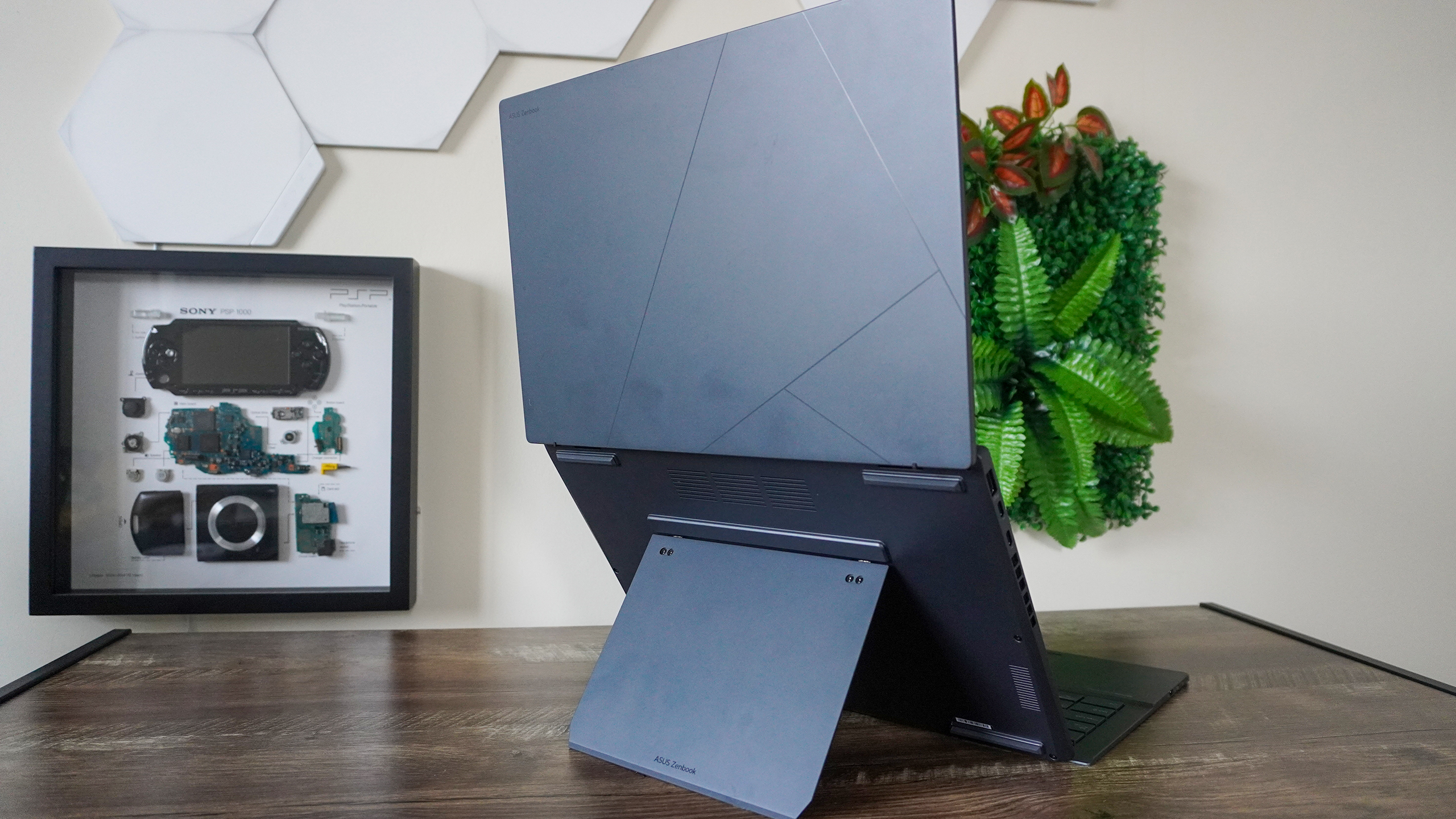
In person, it looks like a rather unassuming laptop when closed — basically like a slightly chunkier Zenbook 14X OLED. In fact, the only real giveaway is that strong hinge on the back to support the two panels. The trademark geometric lines adorn the brushed aluminum lid, which opens to reveal the gorgeous top display and a keyboard/touchpad deck that can be removed for that second panel.
Not only that, but it (mostly) has the dimensions to boot — if only a little bit thicker in a way that most may not notice, thanks to the wedge shape. You can see this when slotting it next to an M3 Pro MacBook Pro.
| Laptop | Dimensions | Weight |
|---|---|---|
| Asus Zenbook Duo (2024) | 12.3 x 8.5 x 0.8 inches | 3.6 pounds |
| Lenovo Yoga Book 9i | 11.8 x 8.0 x 0.6 inches | 3 pounds |
| HP Spectre Fold | 10.9 x 7.5 x 0.8 inches | 3.6 pounds |
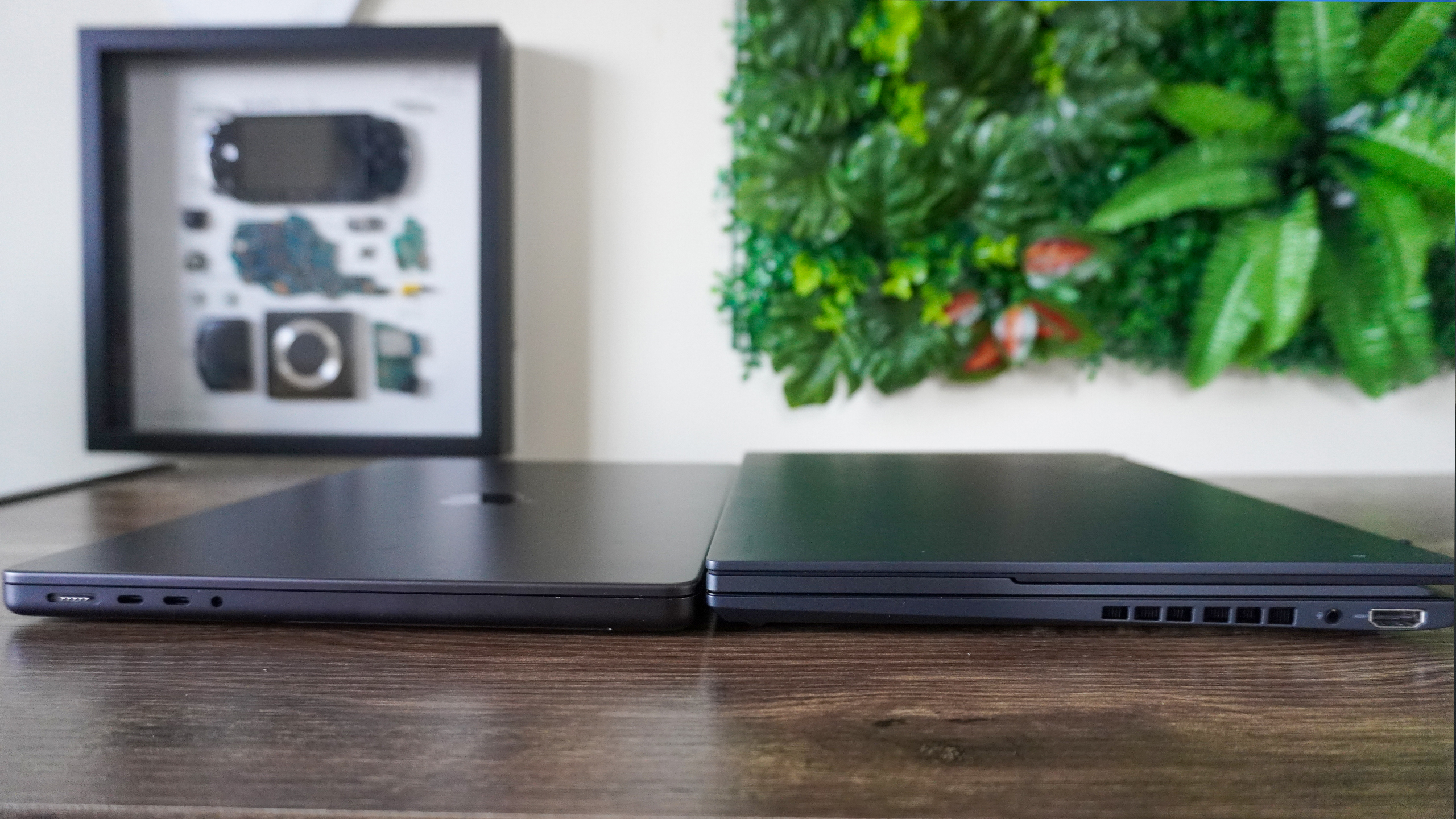
One issue I had with other dual-screen laptops has been the confidence in its rigidity. Whether it’s a hinge that feels a bit flimsy, or the increased number of mechanical parts start to click or creak uncomfortably, there’s always been an air of nervousness to these.
The Zenbook Duo does a complete 180 on this with a strong stand and a hinge that inspires complete confidence in the durability of the system. Rest assured, you’re not going to be feeling iffy about whether this machine can hang, thanks to that military-grade durability proven by passing MIL-STD 810H testing.
This is no slouch
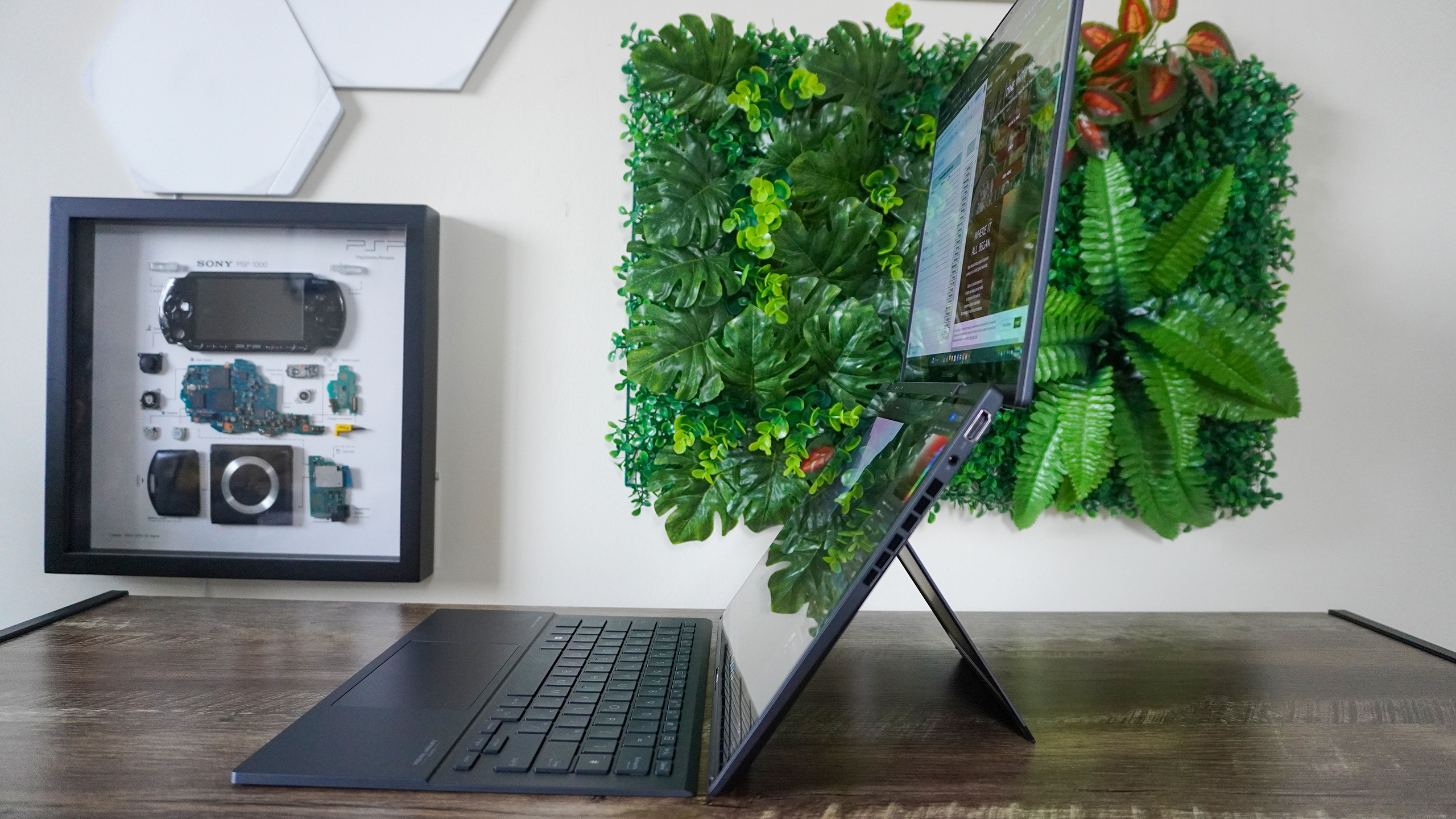
The power of dual-screen laptops has been a bit of an oddity. The $5,000 HP Spectre Fold packs only 12th Gen Intel after all. But Asus is keeping up with the cutting edge by packing its Zenbook Duo with Meteor Lake.
That means you can spec this with up to an Intel Core Ultra 9 185H — sure to keep everything zippy and really turboboost its AI capabilities with that built-in NPU. As for the Ultra 7 155H found in our review unit, the results show a lot of multitasking promise:
| Laptop | Geekbench 6 single-core | Geekbench 6 multicore | SSD transfer rate (MBps) |
|---|---|---|---|
| Asus Zenbook Duo (2024) | 2475 | 12867 | 1349.4 |
| Lenovo Yoga Book 9i | 1813 | 7765 | 1296.2 |
| HP Spectre Fold | 1649 | 6460 | 1085.9 |
With integrated graphics, this may not be the best for gaming. But Intel has made some big in-roads into tackling this by flipping its graphical architecture to be similar to its Arc dGPU. The end result, as you can see from my Asus Zenbook 14 OLED benchmarks, is a tidy bump in performance that should mean you can get some AAA games running at decent frame rates with lower fidelity settings.
| Laptop | 3DMark Night Raid benchmark result |
|---|---|
| Asus Zenbook Duo (2024) | 25623 |
| Lenovo Yoga Book 9i | 17546 |
| HP Spectre Fold | 11015 |
While it’s not the most mind-blowing results, this is more than enough for most of your productivity needs, and I saw no slow-down when putting it through its RAW image-editing paces with Photoshop, while watching a 4K movie, setting up some complex Facebook and using Dall-E to generate an image for an upcoming article.
The best keyboard and touchpad on a dual-screen laptop
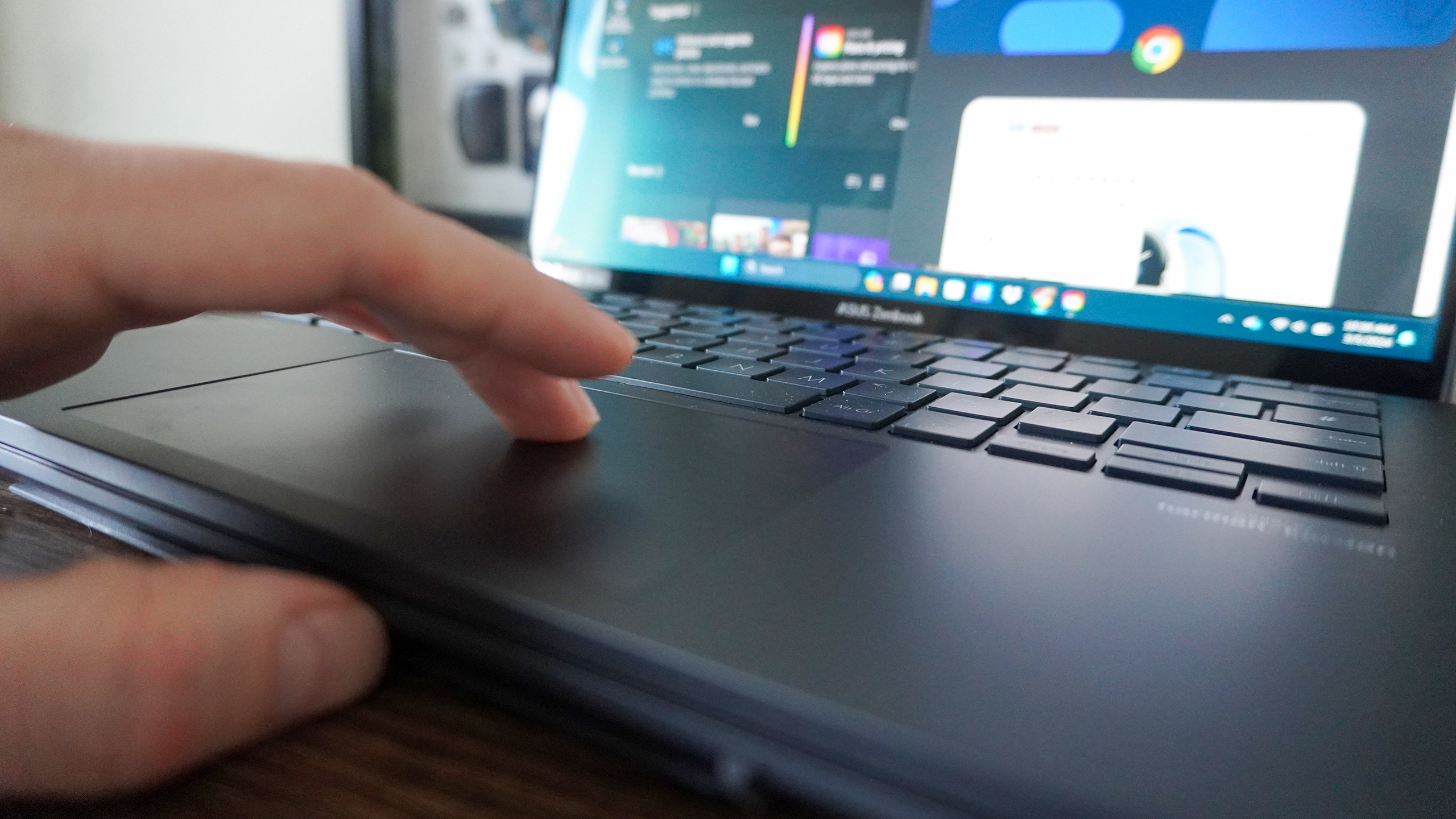
What is the crucial element of this formula? Well, it’s a simple mission statement: a system of this caliber has to be just as good at being both a single screen laptop and dual screen workstation. Don’t get me wrong, the Spectre Fold works just fine with the keyboard attached to the bottom screen, but without that physical touchpad, other companies are missing that tactile feel of navigating/clicking through the OS.
Asus takes a different approach — providing you with a full-size keyboard and physical touchpad that connects to the bottom deck via pogo pins. The keyboard, as you’d expect from the company, is a joy to type on with a decent amount of key depth to give every letter a good feeling of intention, and to have an actual touchpad is miles ahead of its competition.
Plus, it has a battery inside that keyboard lasts for around 10 hours in my own testing, so you’ll be able to convert this into the full big screen beauty for a whole day without any issues whatsoever.
Asus Zenbook Duo (2024): The downs
While some of these problems fade away in the euphoria of how much of a multitasking wizard you become using the Zenbook Duo, there are a couple of sore thumbs here and there.
The port array is lacking
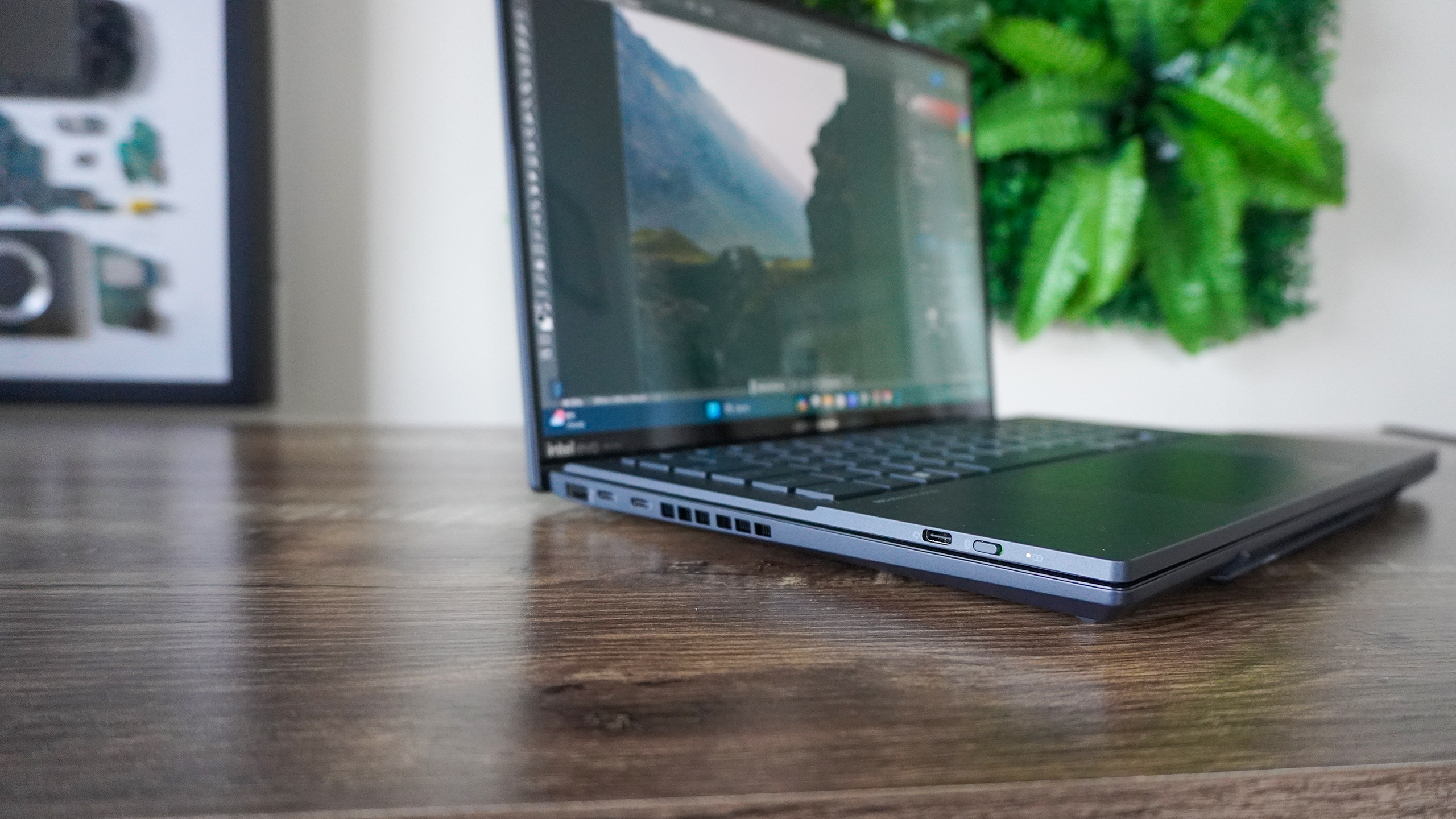
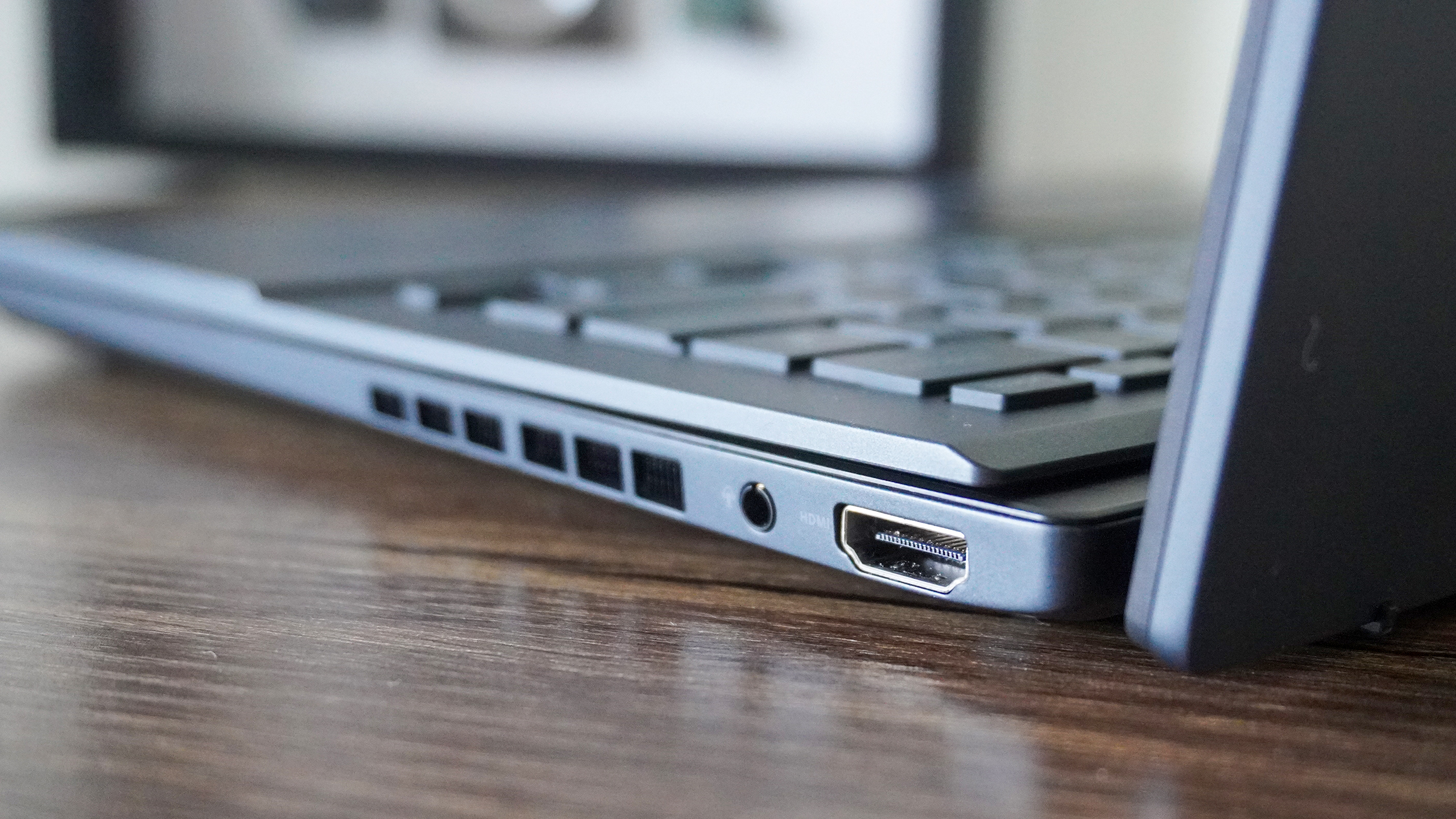
This is probably the one that will hit hardest of the downsides. Don’t get me wrong — it’s not MacBook Air levels of stripping ports away, but with just two Thunderbolt 4, one USB-A and HDMI 2.1 ports (alongside a headphone jack of course), this is missing out on some of the convenience you’d find in other Asus laptops.
Where’s the SD card reader? How about an additional USB-C socket? I don’t think I’m asking for the world here for these simple slots to vastly increase my productivity. Especially since Photoshop runs like a dream on this, so having an easier way to transfer my photos between different devices would be ideal.
Battery life takes a hit
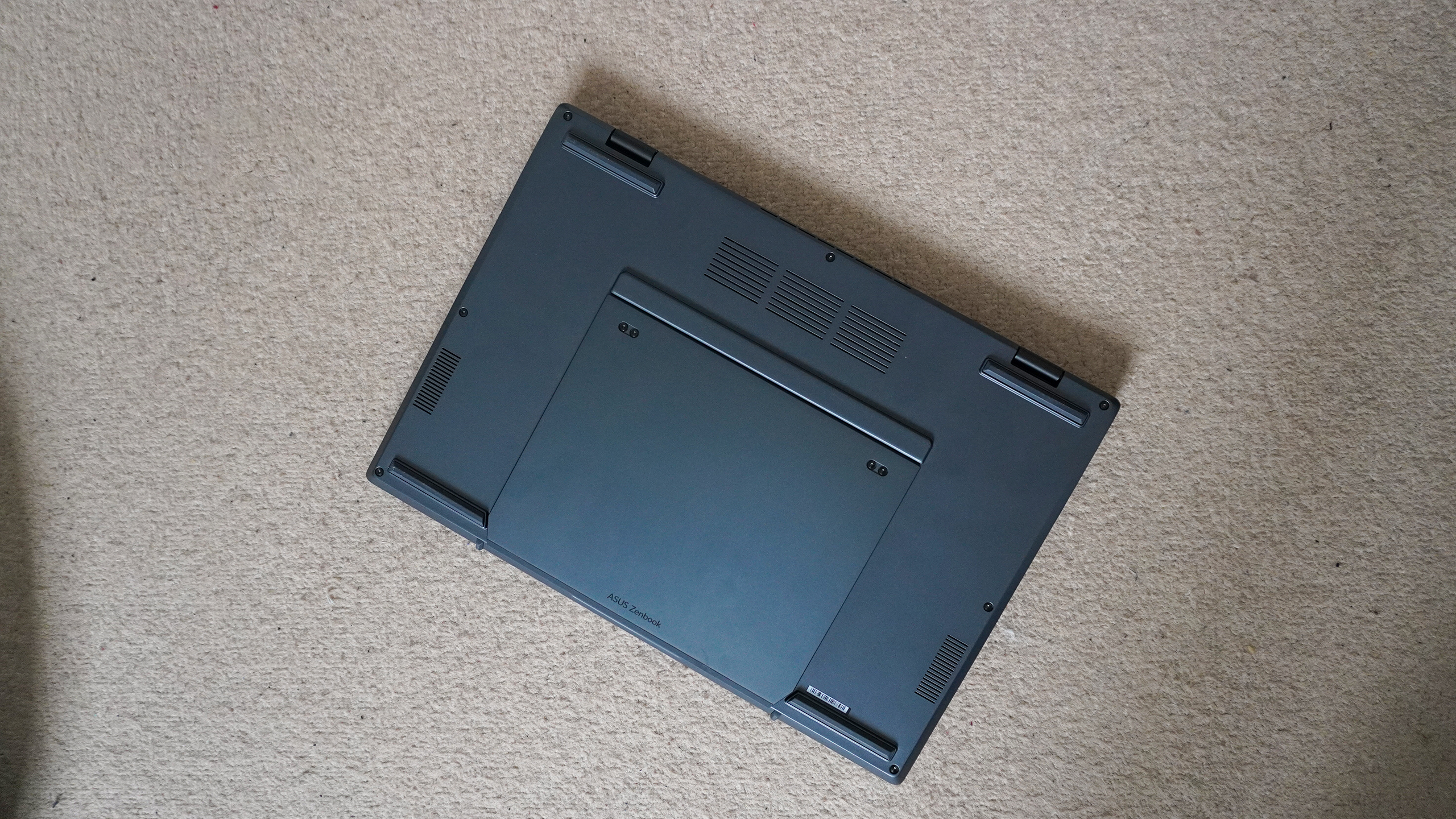
When I got my first hands-on with this laptop back at CES 2024, the first concern was an obvious one: how will the second screen impact battery life? Now that we’ve tested it, I can confirm it takes quite a hit.
| Laptop | Battery life in single-screen mode (hours:minutes) | Battery life in dual-screen mode (hours:minutes) |
|---|---|---|
| Asus Zenbook Duo (2024) | 10:10 | 8:21 |
| Lenovo Yoga Book 9i | 12:14 | 9:18 |
| HP Spectre Fold | 10:45 | 9:46 |
Kudos to Asus for being able to make the dual-screen setup last an entire working day. By going with the latest silicon, the company did set itself a power hungry challenge when paired with two 14-inch OLED panels, so to see it go over 8 hours in our stringent battery testing means this thing has legs.
But in my real world use, which involves some rather strenuous multitasking between 20+ Chrome tabs, Spotify playing in the background and a lot of Photoshop editing, you can see this stamina trickle away at a higher rate. If you’ve got big business on your mind, make sure you’re near a power outlet.
Looking like N64 graphics

Oh, Asus. Why do you mess with me, so? You keep talking about 1080p webcams, but the end result of that resolution bump never really comes to fruition.
It's far from being a potato-level camera — the higher detail is apparent. However, the aperture is very small, which leads to a lot of noise, and that sharpness seems to be turned up to 11 to the point that everything looks quite pixelated. You’re not going to want to use this for anything more than the occasional Zoom call with the team. Luckily it’s not useless, as IR gives you access to Windows Hello login support.
Come on, Microsoft!

Let me be clear. This one is not on Asus. The company has brought it big with some stellar hardware, and did its best to work around Windows 11 with ScreenXpert 3. Keeping this app open in the background gives you all the gestures you need to swiftly navigate the system, such as expanding an app across both screens with five fingers, flicking windows between screens, swapping windows between two screens, and launching pre-saved groups of apps with ease.
Is this enough to get past the Windows weirdness of tackling two touchscreen panels? Sort of, but not really. Some of what Asus is doing should just be built into the OS to begin with — given this is a form factor that seems set to be more commonly adopted. But mainly, something needs to be done to make animations more fluid, to give you a better visual response to your inputs.
Hopefully this is done sooner rather than later. In its current state, it’s usable and provided you put your trust in ScreenXpert3, a lot of fun to work with. But it can feel a little clunky without some smoothness to the way it looks.
Asus Zenbook Duo (2024): Verdict
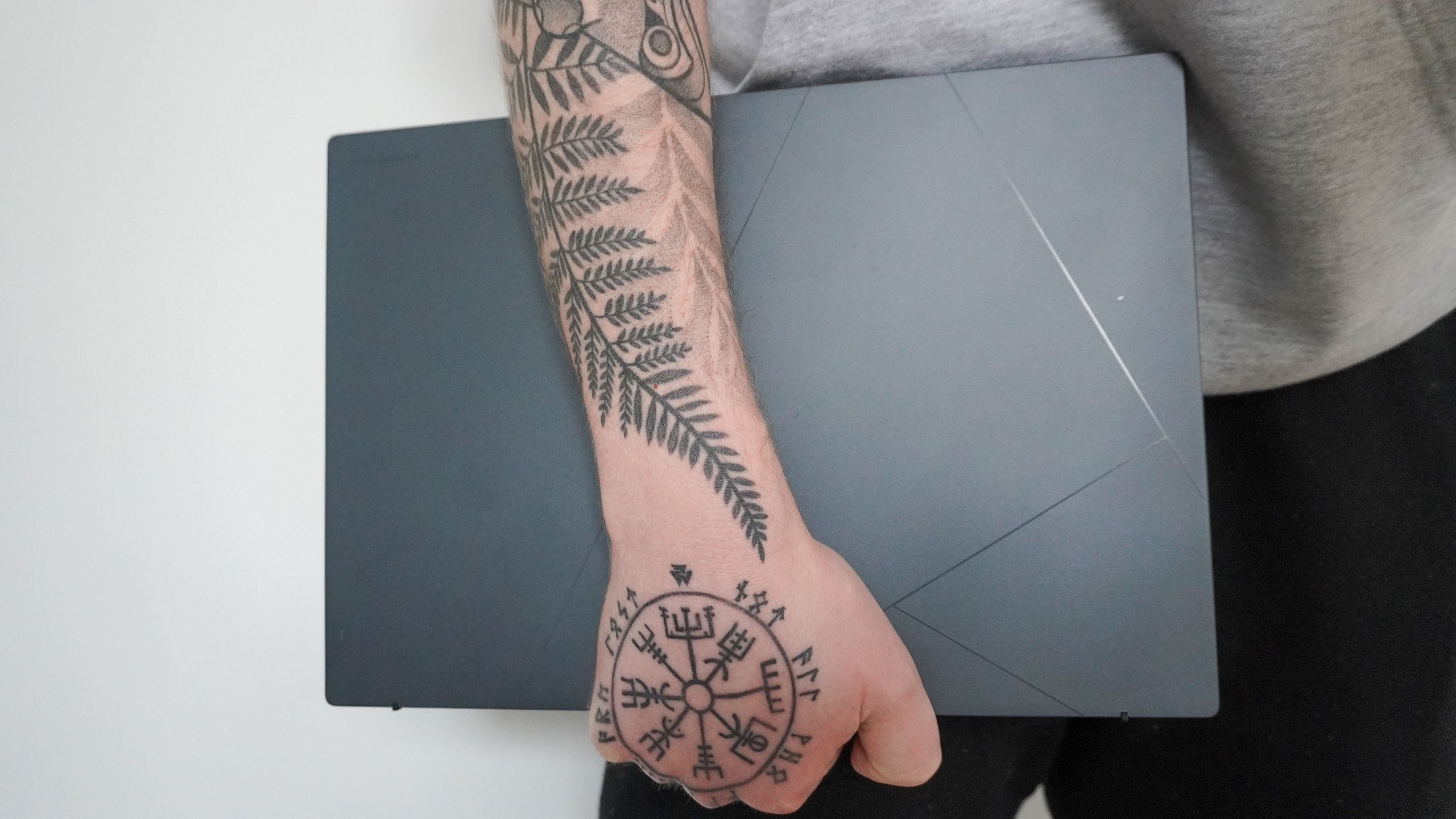
And that is the story of the Asus Zenbook Duo — warts and all, one of the best laptops you can buy right now. The refinements made to something that I thought was more of a concept than a real product has made the Zenbook Duo a machine that can handily replace any single-screen daily driver.
Some of my concerns persist — that second screen impacts the longevity of that 75Wh battery quite significantly, and Windows 11 is still a little awkward at times when reacting to this orientation-agnostic hardware, regardless of the software tweaks Asus has made.
But this is the start of something great. The start of making dual-screen laptops something everyone could realistically buy without hesitation. No more sky high prices, and no more compromised specs.
Even more glowingly, I find myself heading back to more traditional laptops like my MacBook Pro and missing the second screen. This is the real deal, and if you’ve been on the fence, now is the time to buy.

Jason brings a decade of tech and gaming journalism experience to his role as a Managing Editor of Computing at Tom's Guide. He has previously written for Laptop Mag, Tom's Hardware, Kotaku, Stuff and BBC Science Focus. In his spare time, you'll find Jason looking for good dogs to pet or thinking about eating pizza if he isn't already.
-
Briarback The DCI-P3 values you mention are wrong. It's at least around 98-99%. You might have had HDR in Windows on, which reports wrong color values (when on).Reply
